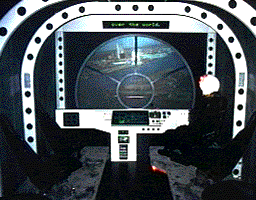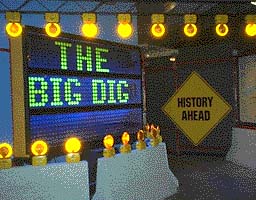Physical + Virtual = Immersion
Whenever I write about technology, there is always an underlying message:
a desire to combine the physical and virtual world so that they are mutually
supportive. My thinking is often influenced by my husband, Fred Raab, whose
work is, literally, combining the physical and virtual; juxtaposing reality
and illusion to create an immersive learning experience.
Fred is a media technologist. He collaborates with designers to produce
interactive, media-intensive exhibits in museums, visitor centers, and
other public spaces. Like most spouses, I hear a lot of details but rarely
get the big picture. So recently, when Fred gave a presentation at a design
conference, I decided to attend. As I watched the reaction of the audience,
I realized that the field of interactive, media-based exhibits is a magnet
for designers. It offers a way to be involved in cutting-edge technology
that goes beyond a pixels-only palette and a screen-only stage. Fred's
presentation outlined the creative opportunities that interactive exhibit
design offers for designers.
Collaboration of Expertise
Fred's experience is in video, theater and computers. His role is conceptualizing
and developing the technology that will best deliver an engaging experience
and message. He works with designers who develop the visual space, and
together they create the exhibit's storyline. Other team members typically
include a fabricator, video producer, writer and programmer.
A few years ago, Alabama Power Company decided to create a visitor center
to show the full extent of the company's responsibilities as steward of
the state's waterways and reservoirs. Fred collaborated with Michael Sand,
an exhibit designer, to develop the 5,000 square foot floor space. In his
talk, Fred summarized the exhibits, each of which required the unique expertise
of each team member.
Waste Not, Want Not is a huge, free-standing wall of six-gallon
water jugs with a touch screen that queries you about your use of water,
and then shows the results by illuminating the appropriate (and often embarrassing!)
number of jugs. In the Mitchell Dam Tour, visitors enter a workshed, then
board a cart; with the aid of a wall sized video monitor and interactive
steering wheel, you "drive" through a hydroelectric plant, meeting
workers along the way. In the Helicopter Flyover ride film, you're
in a simulated helicopter, and a daredevil pilot flies you over Alabama's
900 miles of waterways. The illusion of being in a helicopter is boosted
by Thunder seats with sub-woofer speakers inside: you feel the chopper.

Water Whys, an interactive game show, has members of the audience
compete to demonstrate their knowledge of Alabama waterways. The emcee
appears as live and life-size, but is actually coming from a programmed
videodisc.

Every exhibit combines an effective use of story telling, physical space,
video, computer software, visual graphics and sound.
Immersive Experiences
A primary ambition of a designer is to deeply engage his or her audience.
And that's the potential of interactive media - the ability to bring the
viewer more profoundly into the content. The best interactive experiences
are ones that are immersive, that is, where you are deeply involved in
the subject matter. So how do you create an immersive experience? Here
are three techniques:
1) Immersion in the Environment
Many exhibits are simply open spaces with panels, display cases
and an occasional kiosk. That's a waste. It's much more effective to have
an environment where every element of the space, whether physical or virtual,
is employed to immerse the visitor in the learning process.
Another example Fred showed is the "Big Dig" exhibit at Boston's
Museum of Science, also a collaboration with Michael Sand. Boston is undergoing
a huge construction project to create a new tunnel under the harbor as
well as a new Central Artery, and the exhibit highlights the science and
engineering aspects.

The exhibit entrance pulls you into a new environment and sets you on
a prescribed path; physical scenes and computer-based media teach you about
the construction process and the effects of the Big Dig on everyday life.
About halfway through the exhibit, you get on an elevator and "ride
down" eight stories into an excavation pit. Before your eyes adjust
to the darkness, you see the construction supervisor (actually a video
column, which is triggered to start when the elevator doors open) and he
beckons you to come look through the peepholes in the construction fence.
Unbeknownst to you, the peepholes have two polarized filters, and you're
watching a 3D film: a close-up view of workers constructing a section of
a car tunnel, installing the necessary guts into a 325 feet long steel
pipe.
Fred says it's funny watching visitors as they leave the exhibit and
re-enter the museum: some are visibly shocked when they realize that they're
actually on the same floor and only a few yards from where they first entered
the exhibit.
2) Physical Involvement
Another exhibit that Fred highlighted was Sports Lab, designed by Krent
Paffett, Associates. Personally, I learn best by doing, and the more physical,
the better. So when Fred was putting the finishing touches on an exhibit
for Sports Lab, I tagged along. Sports Lab is a traveling theme park housed
in two inflatable structures, each the size of a football field. They're
filled with sports activities that I loved because they're great combinations
of physical and virtual. For example, I headed straight for the baseball
cage, picked up a bat and got ready for the pitch, which came at 60 mph
from Roger Clemens.
Actually, as Roger's video image pitched a virtual ball, a real ball
came through a hole in the screen, straight over my plate. There was no
learning time involved; I swung immediately, and slammed (well, sort of)
the ball into virtual left field.
3) Immersion through Dialogue
While I was slugging, Fred was wiring his exhibit "You be the Judge,"
an interactive stadium. The audience learns how judges score an Olympic
event, and then get their turn to judge. People like to see each other's
choices, and how they compare to their own.
In his presentation, Fred noted that people become really involved when
they have to reach a consensus. He learned this years ago, while working
on an interactive drama for the National Scouting Museum. The audience
watches a story about a moral dilemma, and is asked to vote: do you tell
your Mom or protect your friend? The audience's vote determines which path
the story will take.
Because of budgeting considerations, the design team wanted to streamline
the video production. To limit the number of options, they decided that
a tie vote would not be permitted. So whenever there was a tie, the audience
was instructed to vote again. Guess what: people talked to each other!
Because a consensus was necessary, they had to convince each other to change
votes. The audiences were extremely vocal, and definitely engaged.
Group dialogue is a subtle but effective form of immersion. When you're
an active participant in decision-making, you're absorbed in the content.
Recreating Authenticity
The most immersive experience is the real thing, when you're in an
authentic environment or activity. On his busman's holidays, Fred always
seeks out places that seem to have been frozen in time, like coal mines,
mills, and one of his favorites, a blast furnace. The goal of these wonderful
places is, above all, preservation; an effort to delay the decay.
But most of the time, the public doesn't have direct access to the things
it wants to experience, either because they were moments in history, or
they're too dangerous or too far away. So the exhibit team must develop
an oxymoron: they must recreate authenticity. A well-chosen blend of physical
structure and virtual simulation creates a feeling, a sense of a place
or experience that no longer actually exists, or is occurring on the other
side of the globe.
One of the liberating aspects of technology for designers is the ability
to go beyond the physicality of print, and to explore the depth of an interactive
screen. But it's even more liberating to come full circle, and add yet
another dimension of physicality, as well as people, to the mix.
© 1996 W. Richmond
editor's note: More pictures can be found on Fred's web site at www.FredRaab.com
|



